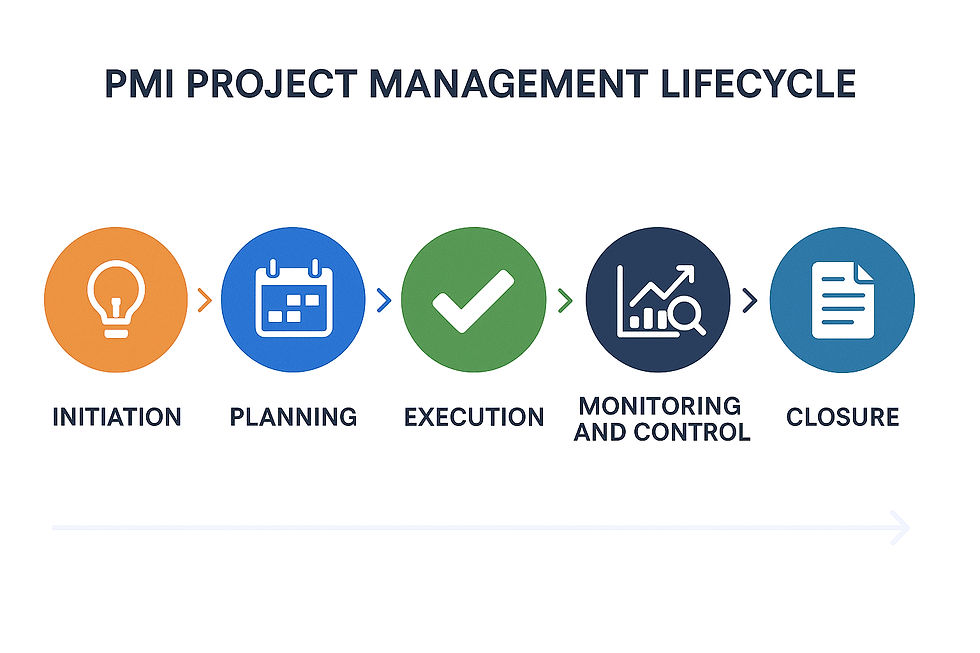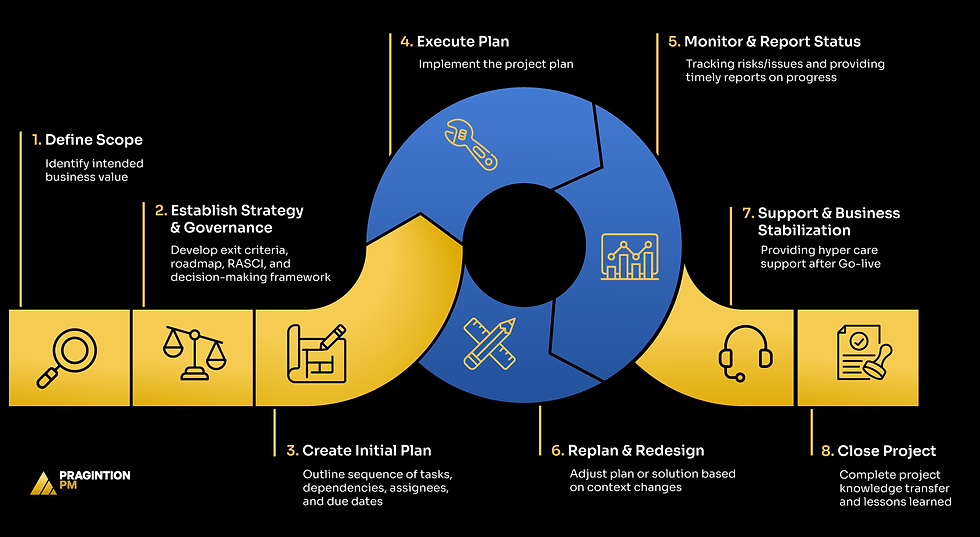Program & Project Management Transformed: Driving Intended Business Value
- Justin M
- Jul 10
- 7 min read
Updated: Sep 6

For decades, the traditional project management lifecycle has provided a reliable structure for delivering work on time, within scope, and on budget. Yet in today’s business environment, rigid methodologies often fall short as organizations navigate internal shifts, changing priorities, and emerging risks.
This article examines the current state of program and project managers (PMs) methodologies and identifies their limitations in dynamic settings. It then introduces a new, adaptive approach focused on achieving intended business value, recognizing that delivering outputs alone is no longer enough.
Inside the Traditional Project Management Methodology
The prevailing standard in program and project management is a structured, five-stage lifecycle that has become the accepted methodology across industries for managing complex work with discipline and consistency.

The five-phase lifecycle is as follows:
Initiation: Organizations establish initial governance, define objectives, assess feasibility, and identify stakeholders. This phase culminates in developing a project charter and securing formal approvals to proceed.
Planning: Detailed plans are created to outline scope, timelines, costs, quality standards, resources, risks, communication strategies, and procurement needs. Baselines are set to serve as reference points for managing progress and performance.
Execution: Project teams carry out the work defined in the plan, coordinating activities, managing resources, and producing deliverables that meet specified quality standards.
Monitoring & Control: Ongoing oversight ensures alignment to the plan, tracks performance, identifies variances, and drives corrective actions to keep the project on course.
Closure: The initiative is formally concluded through acceptance of deliverables, release of resources, documentation of lessons learned, and administrative closure activities.
The Principles of Traditional Program & Project Management Methodology
The five phases of the program & project management lifecycle are supported by core principles that have built the methodology that is popular today:
Structured Planning: Establishing a clear roadmap that defines scope, timelines, resources, costs, and risks upfront.
Controlled Execution: Applying processes to monitor progress, manage changes, and uphold quality standards throughout delivery.
Defined Roles and Responsibilities: Assigning clear ownership and accountability across teams and leadership to ensure alignment and decision-making authority.
Focus on Delivery: Prioritizing the completion of tasks that drive toward the achievement of strategic objectives.
Standardized Processes: Utilizing recognized processes and knowledge areas to create a common language and consistent approach across projects and industries.
Constraint Management: Using defined constraints, scope, schedule, and cost as baselines for measuring performance and controlling deviations.
Prescriptive Approach: Following predefined processes, inputs, outputs, and tools that guide project activities.
Predictive Nature: Operating under the expectation of a linear, planned progression from start to finish, with change managed carefully and deliberately.
Together, these principles have shaped a disciplined methodology aimed at reducing uncertainty and increasing predictability in delivering initiatives. However, the rigidity of this approach can cause complex projects to lose value over time as they struggle to adapt to changing conditions.
The Limits of a Rigid Approach
While widely adopted, conventional project management methodologies have notable gaps that can undermine intended business value:
They assume a linear, sequential progression, where each phase cleanly transitions to the next. In reality, initiatives often need to revisit earlier phases as business context shifts.
They imply the original plan remains static throughout execution. This can pressure project managers to conceal delays or issues to maintain optics, rather than address necessary changes openly.
They overlook the critical need for business stabilization during and after delivery. Execution alone isn’t enough; operational readiness and business viability are essential for sustained success.
They struggle in volatile environments where requirements, stakeholders, or external conditions can rapidly change, from resource shifts and evolving scope to unexpected impediments that reshape the entire initiative.
They emphasize control, despite project managers not having direct authority over all aspects of the initiative. This creates a false sense of security and leads to overly prescriptive approaches ill-suited for dynamic realities.
Rigid adherence to these traditional approaches often results in missed opportunities, costly rework, and erosion of business value. Today’s organizations need methodologies that blend discipline with pragmatism, capable of adapting fluidly to real-world complexity.
The P8 PM Lifecycle, A Modern Methodology
Organizations managing complex initiatives need methodologies that are both fluid and realistic, able to adapt dynamically while keeping business value firmly in focus.
The P8 PM Lifecycle offers a modern, iterative, and context-aware approach that empowers leaders to capture value and drive success, even amid shifting conditions.
This pragmatic, eight-step model equips PMs to respond in real time to changing business contexts, transforming complexity into clarity and keeping outcomes aligned with evolving priorities.

The following eight steps outline the P8 PM Lifecycle, guiding adaptive delivery from start to finish.
Step 1. Define Scope: Establish a clear understanding of the intended business value, define key objectives, and outline the scope. This foundational step ensures all stakeholders align on the ultimate goal of the initiative.
Step 2. Establish Strategy & Governance: A critical yet often under-executed phase that must follow scope alignment. Strategy and governance are developed together to provide both a clear roadmap and a robust decision-making framework.
Strategy: Define the roadmap, milestones, workstreams, resource assignments, exit criteria, communication tools, KPIs, and meeting cadences.
Governance: Identify stakeholders, assign roles and responsibilities via RASCI charts, establish escalation paths, prioritize criteria, create RADIO logs, and define change control processes.
Step 3. Create Initial Plan: Building on the strategy and governance foundation, the project manager collaborates with subject matter experts (SMEs) to define sequential tasks, dependencies, assignments, and deadlines. Involving SMEs ensures accurate effort estimation and fosters accountability and engagement.
🚨Note: Steps 4 through 6 form an iterative cycle, adapting to evolving business context until reaching “go-live” and business stabilization.
Step 4. Execute Plan: Carry out work according to the detailed plan, maintaining focus on quality and alignment with strategic objectives.
Step 5. Monitor & Report Status: Track progress and quality, manage the RADIO log, and generate status reports aligned to the plan. Proactively raise risks and issues for escalation through established governance channels, ensuring timely decision-making.
Step 6. Replan & Redesign: Based on insights gained during execution and monitoring, adjust plans and designs to reflect changing business realities and maintain alignment with objectives.
Step 7. Support & Business Stabilization: Though often overlooked, providing ongoing support and stabilizing the business environment post-implementation is critical to long-term success.
Step 8. Close Project: Formalize documentation, capture lessons learned, and transfer knowledge and responsibilities to those managing long-term operations and support.
Together, these eight steps provide a flexible, pragmatic approach that empowers organizations to navigate complexity and deliver sustained business value in today’s dynamic environments.
The Modern Principles Guiding the P8 PM Lifecycle
The P8 PM Lifecycle is grounded in core principles crafted to meet today’s complex and dynamic business realities:
Iterative Adaptation: Continuously refining plans and approaches as new information and changing contexts emerge.
🚨Note: Agile principles drive flexible, iterative delivery at the team level, but often lack structures for managing broader business context and governance. The P8 PM Lifecycle fills this gap, offering a framework-agnostic, adaptive approach for complex initiatives, ensuring alignment to business value and stability beyond delivery. It complements Agile rather than replaces it, bridging strategy and execution in dynamic environments.
Contextual Awareness: Maintaining real-time understanding of organizational shifts, stakeholder changes, and external influences.
Collaborative Governance: Establishing transparent decision-making processes that engage stakeholders, clarify roles, and enable timely escalation.
Value-Centric Focus: Driving outcomes that deliver measurable business value, not just task completion (aligned with the V5 Model).
Framework Agnostic: Seamlessly integrating with Scrum, Waterfall, or hybrid delivery methods suited to the organization and initiative.
Dynamic Constraint Management: Treating scope, schedule, and cost as adjustable parameters, balanced with business priorities and risks.
Information-Driven Influence: Building authority through accurate, timely data transparently shared with business leaders.
Business Stabilization Emphasis: Recognizing and planning for the critical post-implementation phase that stabilizes operations and secures long-term success.
Together, these principles form the foundation for a methodology that delivers real business value, turning adaptability into a competitive advantage.
The Power of Business Context Adaptation towards Achieving Intended Business Value
Traditional program and project management often struggles in dynamic environments due to its reliance on fixed plans and linear progression. In contrast, the P8 PM Lifecycle delivers power and flexibility through:
Built-in Flexibility: Accepts change as inevitable, embedding adaptability into strategy and governance from the start.
Continuous Alignment: Enables real-time adjustments and responsive decision-making as business contexts evolve.
Influence over Authority: Recognizes PMs rarely hold full control, emphasizing influence through timely, accurate information shared within established governance structures.
Holistic Monitoring: Extends beyond traditional metrics to incorporate political, economic, and social factors that affect project outcomes.
Transparent Reporting: Ensures decision-makers receive clear, actionable insights to manage risks and capitalize on opportunities.
Business Support & Stabilization: Prioritizes operational readiness and sustained value post-delivery, reducing disruption and securing long-term success.
Together, these elements position the P8 PM Lifecycle as a pragmatic, intentional, and powerful methodology, designed for organizations navigating complexity and change while maintaining a sharp focus on achieving intended business value.
Methodologies Must Evolve or Fall Behind
As business environments grow increasingly complex and dynamic, traditional project management methodologies no longer suffice on their own. Organizations must adopt approaches that are both disciplined and adaptable, capable of evolving alongside shifting macroeconomic conditions, technological advancements, and organizational priorities.
The P8 PM Lifecycle exemplifies this modern approach, embedding iteration, governance, and real-time adaptation to ensure projects deliver sustained business value. As markets and technologies continue to evolve, so too must the methodologies that guide program and project delivery. The key will be to remain flexible, pragmatic, and relentlessly focused on intended business value.
---
Pragintion PM, we specialize in navigating ambiguity and high-stakes environments tied to complex initiatives.
Our program & project management services are grounded in a pragmatic, intentional approach delivered through a client-validated methodology that gets results.
Found this article helpful?
✅ Share it with your network
📌 Save it for future reference
Follow Pragintion PM for more insights on driving real business value from complex programs and projects.

- J&A TBC LLC 2025©



